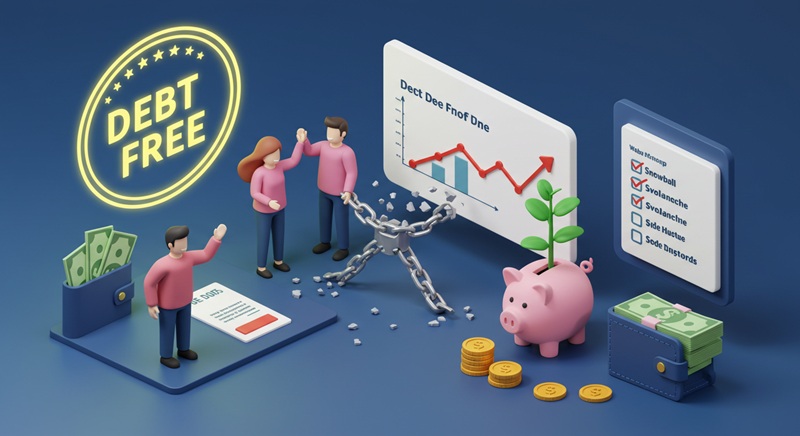Growth Mindset in 2025: Why You Can’t Succeed Without It

In 2025, the only way to thrive is to embrace change—can you afford to stay stuck in a fixed mindset?" The world is moving fast, and those with a growth mindset—believing skills can improve with effort—will lead the way. Meanwhile, a fixed mindset (thinking abilities are set in stone) will hold you back.
Why does this matter now? With AI, remote work, and constant innovation, adaptability is everything. In this post, you’ll learn why a growth mindset is a must-have for success in 2025, how to develop one, and real-life examples of people winning with it.
1. What Is a Growth Mindset? (And Why It Matters)
The Basics: Growth vs. Fixed Mindset
Psychologist Carol Dweck discovered that people generally have two mindsets: growth and fixed. Those with a growth mindset believe skills can improve with effort, while those with a fixed mindset think talent is set in stone.
For example, imagine two students failing a math test:
- Fixed mindset:"I’m just bad at math—I’ll never get it." (Gives up)
- Growth mindset:"This is tough, but I can learn from my mistakes." (Tries new strategies)
The difference? One sees challenges as dead-ends, the other as opportunities.
Why a Growth Mindset is Essential in 2025
The world is changing faster than ever. AI, remote work, and new industries mean adaptability is no longer optional—it’s survival.
- Tech moves fast: Skills from 5 years ago may already be outdated. A growth mindset keeps you learning.
- Employers want learners: Companies now hire for learning agility—the ability to pick up new skills quickly.
- Mental resilience matters: With job shifts and economic uncertainty, bouncing back is crucial.
Real-life example: A friend lost her job to automation but used online courses to switch careers. Instead of panicking, she saw it as a chance to grow—and landed a better role.
Pro tip: In 2025, standing still means falling behind. A growth mindset isn’t just helpful—it’s non-negotiable.
2. How a Growth Mindset Drives Success in 2025
Career Growth & Workplace Success
The job market is evolving rapidly, and those who upskill stay ahead. Take Andrew, a marketing expert who noticed AI tools replacing basic tasks. Instead of fearing obsolescence, she took online courses in AI-powered marketing—and became his company’s go-to expert.
- Future jobs demand adaptability: Roles like AI trainers and sustainability managers didn’t exist a decade ago. A growth mindset helps you pivot.
- Feedback = fuel: Fixed mindset: "My boss criticized my report—I’m terrible at this." Growth mindset: "Now I know how to improve."
Education & Lifelong Learning
Students today face tougher competition, but challenges build resilience.
- Embracing struggle: A student struggling with coding might quit (fixed mindset) or practice daily (growth mindset). Guess who lands the internship?
- Self-improvement is trending: Platforms like Coursera and Khan Academy make lifelong learning accessible. The best part? You can learn anything, anytime.
Personal Development & Relationships
A growth mindset transforms personal growth too.
- Beating self-doubt:"I’m not leadership material" becomes "I can develop these skills."
- Stronger relationships: Admitting mistakes and learning from conflicts deepens connections.
Real-life win: My cousin failed his driving test 3 times but kept practicing. On his 4th attempt, he passed—and gained unshakable confidence.
Pro Tip: In 2025, success belongs to those who see potential, not limits. Whether it’s future jobs, education, or personal growth, a growth mindset turns obstacles into opportunities.
3. Signs You Have a Fixed Mindset (And How to Change It)
Red Flags of a Fixed Mindset
Do you avoid challenges because you’re afraid to fail? Or feel threatened when others succeed? These are classic signs of a fixed mindset.
- Example:I used to always sticks to easy tasks at work because I thought "hard projects may expose my weaknesses." Meanwhile, there was a colleague who tackled tough assignments got promoted.
- Fixed mindset thinking: "They’re just naturally talented—I’ll never be that good."
How to Develop a Growth Mindset
The good news? You can rewire your thinking.
- Use the word "yet":
Instead of "I can’t do this," say "I can’t do this yet."
Example: A student struggling with math may says, "I don’t understand algebra—yet." This small shift creates a chance for growth.
- See failure as feedback:
Failed a job interview? Instead of "I’m not cut out for this," ask "What can I learn from this?"
- Ask for feedback—and mean it:
Fixed mindset: "My manager’s criticism hurts."
Growth mindset: "This feedback helps me improve."
Pro tip: Spotting fixed mindset traps is the first step to changing them. With practice, you can turn self-doubt into fuel for growth.
4. Real-Life Examples of Growth Mindset Wins in 2025
Tech Leaders & Innovators
Big companies like Google and Microsoft thrive because they reward experimentation, not just success. At Google’s innovation labs, employees test bold ideas—even if they fail. Why? Because breakthroughs come from trying, learning, and trying again.
- Example: Google’s AI team failed hundreds of times before perfecting their chatbot. Instead of quitting, they tweaked their approach—and now lead the AI race.
Growth Mindset Application
You don’t need to work at a tech giant to win with a growth mindset.
- Career Changers: Sarah, a 35-year-old accountant, felt stuck. She spent nights learning digital marketing online. A year later, she landed a remote job with double her old salary.
- Students Who Persisted: Daniel did not pass his coding bootcamp’s first test. Instead of dropping out, he practiced daily—debugging one problem at a time. By graduation, tech firms were fighting to hire him.
Pro tip: Whether in tech or daily life, persistence pays off. The difference between success and struggle? Believing growth is possible.
Conclusion: Your Growth Mindset Starts Today
In 2025, a growth mindset isn’t just helpful—it’s essential. From career changes to tech breakthroughs, those who embrace challenges, learn from failures, and keep improving will thrive.
Your move? Start small. Pick one area this week—whether it’s learning a skill, handling feedback better, or tackling a fear—and apply a growth mindset.
"The future belongs to those who believe in growth. Will you be left behind?"
Frequently Asked Questions (FAQs)
1. What is a growth mindset?
A growth mindset is the belief that skills and intelligence can be developed through effort, learning, and persistence. Unlike a fixed mindset (which assumes abilities are static), it embraces challenges as opportunities to grow.
2. Why is a growth mindset important in 2025?
With rapid technological changes, job market shifts, and AI advancements, adaptability is critical. A growth mindset helps you stay relevant, resilient, and open to lifelong learning—key traits for future success.
3. How can I develop a growth mindset?
Start small:
- Replace "I can’t" with "I can’t yet."
- View failures as feedback.
- Seek challenges instead of avoiding them.
4. Can a growth mindset improve career success?
Absolutely! Employers now prioritize learning agility—the ability to adapt and upskill quickly. Those with a growth mindset advance faster, pivot careers easier, and handle setbacks better.
5. What’s the difference between growth vs. fixed mindset?
- Growth mindset:"I can improve with effort."
- Fixed mindset:"My abilities are set in stone."
Example: A fixed mindset avoids challenges; a growth mindset embraces them.










.jpg)
